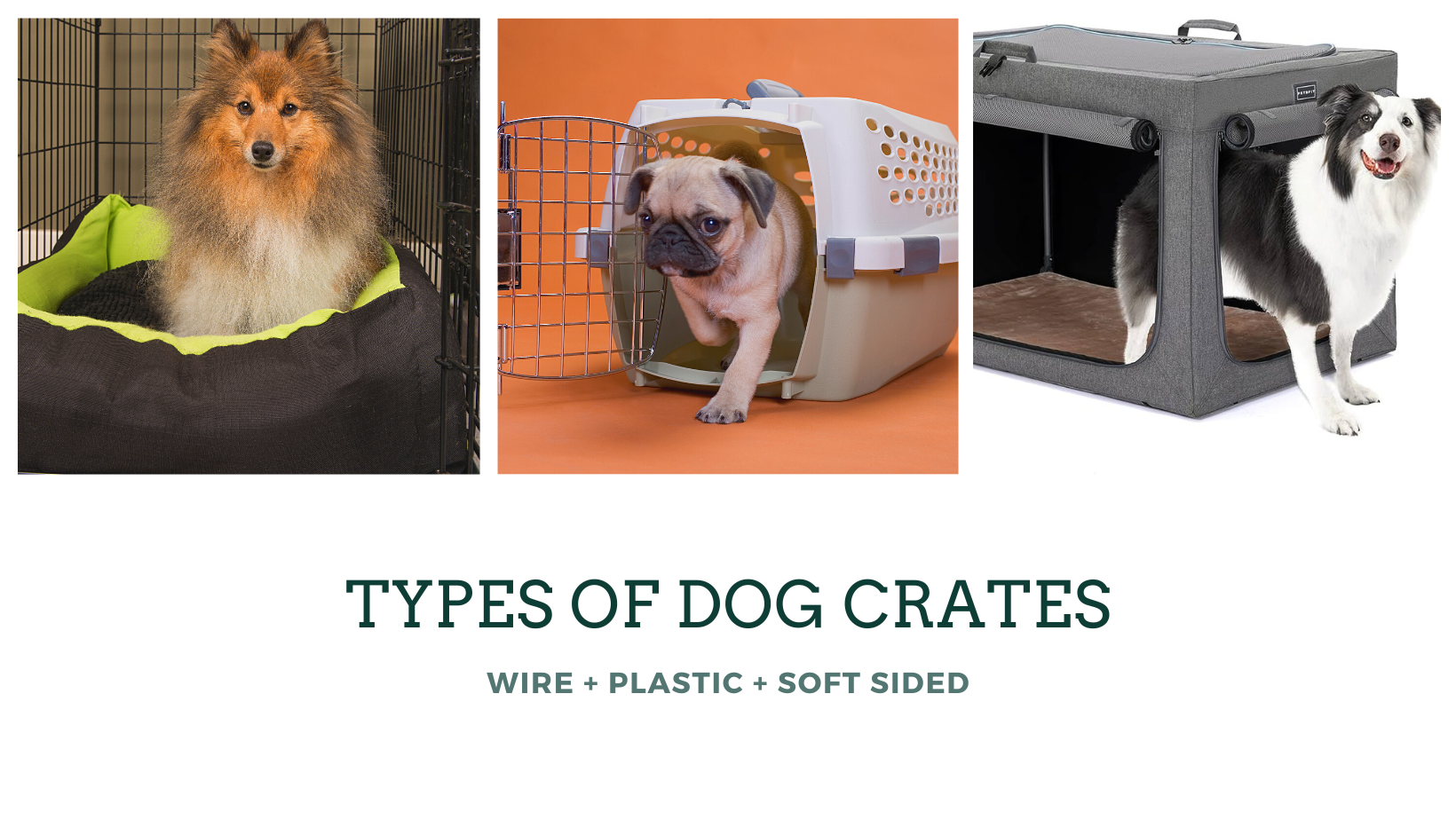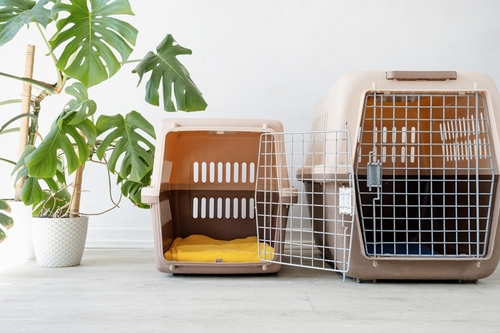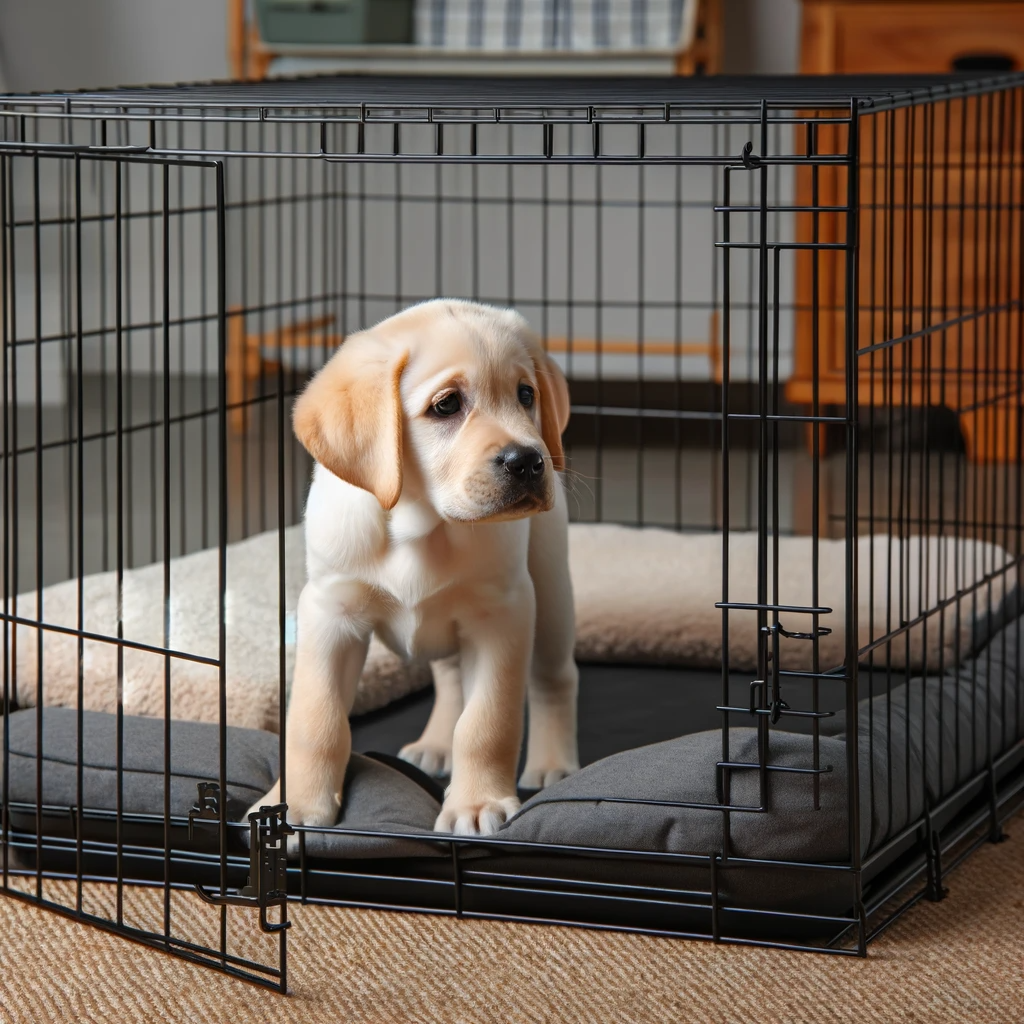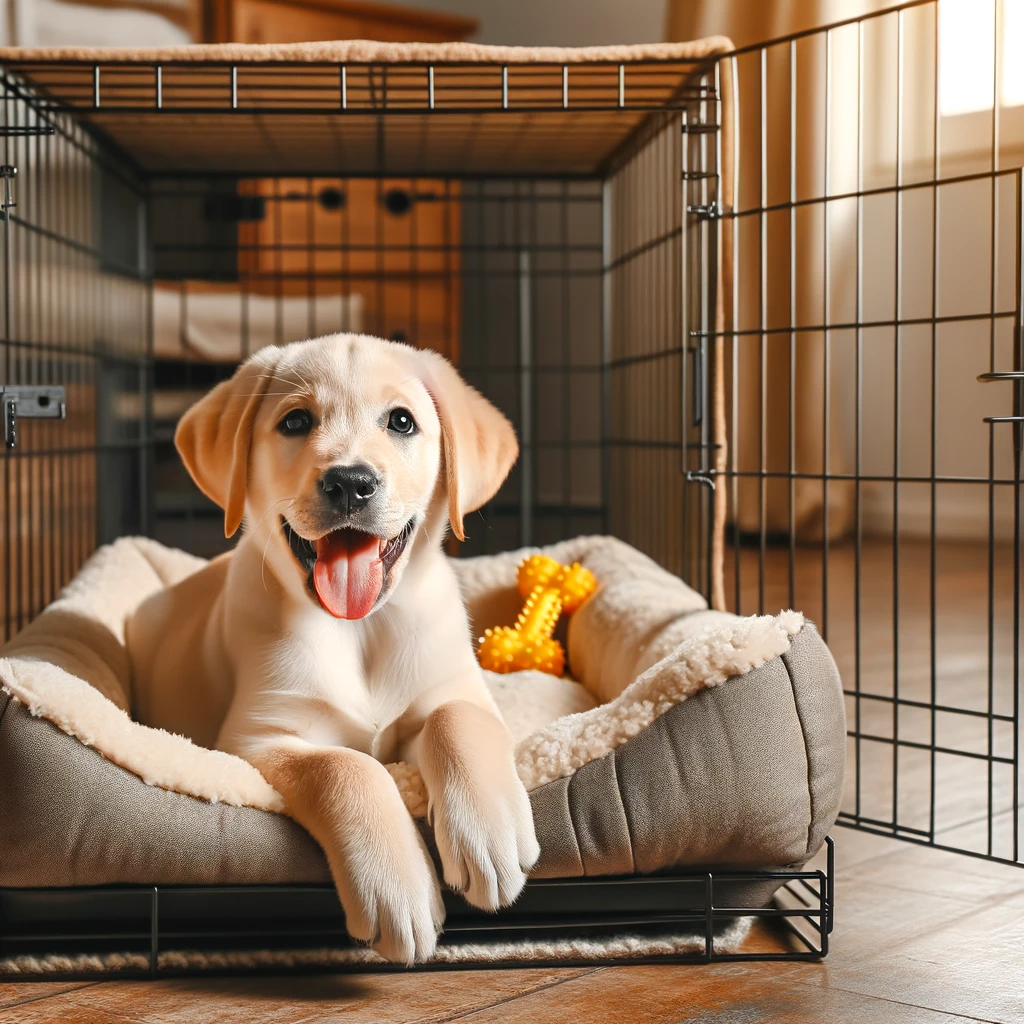Introduction:
Crate training is an essential aspect of raising a Labrador puppy, known for their friendly nature and rapid growth. This guide offers a structured approach to crate training, tailored specifically for the needs of a Lab puppy. By understanding the unique characteristics of Labradors and employing effective training techniques, you can ensure a positive and successful crate training experience for both you and your new puppy too.
Key Takeaways:
-
Breed-Specific Traits: Gain insights into Labrador puppies’ temperament and how it influences crate training.
-
Choosing the Right Crate: Tips on selecting the appropriate crate size and type for your growing Lab puppy.
-
Integrating Potty Training: Strategies for effectively combining crate and toilet training for efficient housebreaking.
-
Overcoming Training Challenges: Solutions for common issues like puppy anxiety, resistance to the crate, and ensuring adequate exercise.
-
Training Through Life Stages: Guidance on adapting crate training as your Lab puppy grows into adulthood and beyond.
Embarking on crate training your Labrador puppy is a journey that fosters a sense of security and establishes good habits in most dogs. This guide is designed to provide you with the knowledge and tools needed to make crate training a rewarding experience for both you and your Lab puppy.
Read More: Dog Crate Training Pros and Cons
2. Understanding Labrador Puppies

Before diving into crate training, it’s crucial to understand the specific characteristics of Labrador puppies. This breed-specific knowledge greatly influences your training approach and ensures more effective results.
Breed Characteristics: Temperament, Size, and Growth
-
Friendly and Energetic: Labradors are known for their friendly, outgoing nature and high energy levels. They are quick learners but require ample physical and mental stimulation.
-
Rapid Growth: Labrador puppies grow quickly, so their size and strength increase significantly in a short time. This growth should be considered when selecting a crate and during training.
-
Intelligent and Eager to Please: Labs are intelligent and generally eager to please their puppy owners, which can make training more straightforward if approached correctly.
Special Training Needs for Labrador Puppies
-
Consistent Training: Labs respond well to consistent training methods. Their intelligence and eagerness to please make positive reinforcement particularly effective.
-
Socialization and Stimulation: Early socialization and exposure to various environments and situations are crucial. Mental stimulation through training exercises and interactive play helps in their overall development.
-
Managing Teething and Chewing: Labrador puppies go through a teething phase where they may chew on anything they can find, including their crate. Providing appropriate chew toys can help manage this behavior.
Training Considerations:
-
Patience is Key: Labs are energetic and can sometimes be overexcited. Training requires patience, especially when they are young and full of energy.
-
Exercise is Essential: Regular exercise is crucial for Lab puppies to burn off energy, making them more inclined to relax in their crate.
-
Positive Reinforcement Works Best: Using treats, praise, and affection as rewards for desired behavior during crate training is highly effective for Labradors.
Understanding these traits and considerations is vital in effectively crate training a Labrador puppy. Tailoring your approach to suit their temperament and needs will lead to a more successful training experience.
Read More: Behavioral Training in Dogs
3. Selecting the Right Crate

Choosing the right crate is a fundamental step in crate training your Labrador puppy. The ideal crate not only accommodates your puppy’s size and growth but also ensures comfort and safety throughout the training process.
Determining the Ideal Crate Size for a Growing Lab Puppy:
-
Room for Growth: Select a crate that accommodates your Lab’s rapid growth. It should be large enough for them to stand, turn around, and lie down comfortably. A crate with adjustable dividers can be beneficial, allowing you to increase the space as your puppy grows.
-
Avoiding Excess Space: While the crate should be spacious enough for comfort and movement, excessive space can hinder potty training, as puppies might use an extra area as a bathroom spot.
Types of Dog Crates and Their Pros and Cons:
-
Wire Crates:
-
Pros: Good ventilation, visibility, and adjustable with dividers. Easy to clean and durable.
-
Cons: Can be bulky and less portable. Might require additional bedding for comfort.
-
-
Plastic Crates:
-
Pros: More enclosed and can feel more secure for some puppies. Good for travel.
-
Cons: Limited airflow and visibility. Can retain heat in warmer climates.
-
-
Soft-Sided Crates:
-
Pros: Lightweight and portable, ideal for travel or temporary use.
-
Cons: Not suitable for puppies prone to chewing. Less durable and challenging to clean.
-
Considerations for Crate Placement:
-
Location in the Home: Place the crate in a quiet yet accessible area where your puppy can see and feel part of the family. Avoid isolated locations, as Labs are social animals and prefer being around their people.
-
Safe and Quiet Environment: Ensure the crate area is free from hazards and not in a high-traffic zone to reduce stress and distraction during crate time.
Selecting the right crate for your Labrador puppy involves considering their size, growth potential, and the crate’s type and placement. The right choice will greatly aid in making the crate training process smooth and effective.
4. Preparing for Crate Training

Set up and proper preparation is key to successfully crate training a Labrador puppy. This involves creating a welcoming environment within the crate and introducing your puppy to it in a positive and encouraging manner.
Creating a Comfortable Crate Environment:
-
Cozy Bedding: Place a soft, washable bed or a blanket inside the crate. Comfort is crucial to make the crate an inviting space for your Lab puppy.
-
Safe Chew Toys: Since Lab puppies are prone to chewing, especially during teething, provide safe chew toys within the crate to keep them occupied and protect them from chewing on the crate itself.
-
Water Access: For longer stays in the crate, ensure your puppy has access to fresh water. Attachable water bowls or bottles designed for crates are practical options.
Introducing Your Lab Puppy to the Crate:
-
Gradual Introduction: Allow your puppy to explore the crate at their own pace without forcing them in. You can encourage exploration by placing treats or toys inside.
-
Positive Associations: Each time your puppy enters the crate, offer praise and treats. This positive reinforcement helps them associate the crate with enjoyable experiences.
-
Feeding Inside the Crate: Begin by placing your puppy’s food bowl near the crate, gradually moving it inside. This will help your puppy associate the crate with positive events like mealtime.
Building a Crate Training Routine:
-
Consistent Schedule: Establish a regular routine for using the crate. Include specific times for meals, play, and crate time to help your puppy adjust to a structured day.
-
Short Duration at First: Initially, have your puppy spend short periods in the crate while you are present. Gradually increase the duration as they become more comfortable.
-
Monitoring and Adjustment: Pay attention to how your puppy reacts to being in the crate. If they seem anxious or distressed, shorten the crate time and gradually increase it as they become more accustomed.
Preparing for crate training involves more than just closing the door and placing your Lab puppy in a crate. It’s about creating a positive and comfortable environment and gradually introducing the crate as a safe and enjoyable space for your young puppy too.
5. The Crate Training Process

Crate training a Labrador puppy requires a structured and patient approach. Following a step-by-step method ensures that your puppy adapts to the crate comfortably and sees it as a safe space.
Step-by-Step Guide to Crate Training a Labrador Puppy:
-
Step 1: Encouraging Voluntary Entry: Use treats and toys to encourage your Lab puppy to enter the crate willingly. Reward them every time they go inside, gradually increasing the time they spend in the crate.
-
Step 2: Feeding Meals Inside the Crate: Start feeding your puppy their meals inside the crate. This helps them associate the crate with positive experiences. Begin with the crate door open, then gradually close it during meal times and open it immediately after they’re done eating.
-
Step 3: Increasing Crate Duration: Once your puppy is comfortable eating in the crate, begin leaving them in it for short periods while you’re home. Start with about 10-15 minutes and gradually increase the duration, ensuring they’re comfortable and relaxed.
-
Step 4: Leaving the Puppy Alone: When your puppy can stay calmly in the crate for about 30 minutes, start leaving them in it while you leave the house. Begin with short departures and gradually increase the time as they become more accustomed to being alone.
-
Step 5: Overnight Crating: If overnight crating is necessary, place the crate in your bedroom or nearby initially, so your puppy doesn’t feel isolated. Gradually move the crate to its intended long-term location as your puppy becomes more comfortable.
Creating a Positive Crate Experience:
-
Use Positive Reinforcement: Consistently use treats, praise, and affection to reinforce a positive association with the crate.
-
Comfort Items: Include a comfortable bed and safe toys in the crate. A piece of clothing with your scent can also provide comfort to your puppy.
-
Avoid Using the Crate for Punishment: The crate should always be associated with positive experiences, not as a space for punishment.
Monitoring Your Puppy’s Adaptation:
-
Watch for Signs of Distress: If your puppy shows signs of stress or discomfort, such as excessive whining or scratching at the crate, reduce the time they spend inside and gradually increase it as they adapt.
-
Be Patient and Flexible: Every puppy is different, and some may take longer to get comfortable with the crate. Adjust the training pace based on your puppy’s individual response.
Crate training a Labrador puppy is a gradual process that should be positive and stress-free. Through patience, consistency, and a few seconds of positive reinforcement, your Lab puppy can learn to view the crate as a secure and happy place.
6. Integrating Potty Training with Crate Training

Combining dog crate training with potty training is an efficient approach for Labrador puppies. The crate encourages puppies to develop bladder and bowel control, as dogs have a natural instinct to avoid soiling their sleeping area.
Establishing a Potty Training Routine:
-
Scheduled Potty Breaks: Set a regular schedule for potty breaks, crucial after meals, playtime, and naps. Labrador puppies generally need to go outside every 2 to 3 hours.
-
Immediate Post-Crate Potty Trips: Always take your puppy to their designated potty area right after releasing them from the crate. This teaches them to hold it while in the crate and go when they are outside.
Crate as a Potty Training Aid:
-
Preventing Indoor Accidents: Utilize the crate when you can’t supervise your puppy, helping to prevent accidents around the house.
-
Building Bladder and Bowel Control: Gradually increase the time your puppy spends in the crate, which aids in developing their control. However, be mindful of their limits, especially in younger puppies.
Responding to Unsuccessful Potty Trips:
-
If They Don’t Go: If your puppy doesn’t relieve themselves at their designated spot, calmly bring them back to the crate. Avoid making a fuss, as this might create anxiety around potty time.
-
Trying Again: After about 15-20 minutes, take your puppy back to the potty area to try again. This interval reinforces the idea of specific times and places for elimination.
Handling Nighttime Potty Training:
-
Last Call Before Bed: Make sure to take your puppy out to their potty area right before bedtime.
-
Puppies’ Nighttime Needs: Young Labrador puppies may require a bathroom break during the night.
Gradually extend the duration between nighttime breaks as they grow older and can hold their bladder for longer periods.
Dealing with Accidents:
-
Stay Calm and Clean Up: If an accident occurs, calmly clean the area with an enzymatic cleaner to remove odors and discourage future accidents in that spot.
-
Reassess the Schedule: Frequent accidents may indicate a need to adjust the potty break schedule or to consult a veterinarian for any underlying health issues.
Integrating crate training with potty training for your Labrador puppy requires patience, consistency, and a clear understanding of your dog’s cues and needs. By establishing a routine and responding appropriately to both successes and challenges, you can effectively housebreak your puppy while making the crate a comfortable and familiar space.
7. Addressing Common Crate Training Challenges

Crate training a Labrador puppy, while rewarding, can present certain challenges. Understanding and effectively addressing these challenges is crucial for a smooth and successful puppy crate training experience.
Handling Vocalization and Whining:
-
Labrador Puppies and Vocalization: It’s common for puppies, including Labs, to whine or bark in the crate, often due to separation anxiety or the need for attention.
-
Soothing Techniques: Providing a comforting item like a blanket or a toy with your scent can help calm your puppy. Ignoring whining (as long as their needs are met) teaches them that puppy whines do not lead to attention.
-
Gradual Desensitization: Gradually increasing the time your puppy spends in the crate helps them get accustomed to being alone without feeling abandoned.
Overcoming Resistance to the Crate:
-
Positive Crate Introduction: Start by encouraging your Lab puppy to explore the crate with treats and praise, creating a positive association.
-
No Forceful Encouragement: Avoid forcing your puppy into the crate, as this can cause fear or resistance. Let them enter and exit the crate at their own pace.
-
Feeding Inside the Crate: Placing meals inside the crate can help your puppy associate it with positive experiences, reducing resistance over time.
Dealing with Separation Anxiety:
-
Short Absences: Begin by leaving your puppy in the crate for short periods while you’re home, gradually increasing the duration of your absences.
-
Comfort Items: Include a comforting toy or an item with your scent in the crate to help ease anxiety.
-
Routine and Consistency: Establishing a consistent routine for crate time helps reduce separation anxiety, as your puppy learns what to expect.
Managing High Energy:
-
Adequate Exercise: Labrador puppies are energetic and require ample physical activity. Ensure your puppy gets enough exercise before crate time to help them relax.
-
Mental Stimulation: Provide mental stimulation with puzzle toys or training exercises to keep your puppy engaged and prevent boredom-related restlessness while in the crate.
8. Balancing Crate Time with Exercise and Play

A crucial aspect of crate training your puppy is finding the right balance between time spent in the crate and time dedicated to exercise and play. This balance is vital for the physical and mental well-being of an energetic and playful breed like the Labrador.
Importance of Physical Exercise:
-
Regular Exercise Regimen: Labrador puppies, known for their high energy, require regular and consistent exercise to maintain their health and happiness.
-
Variety of Activities: Incorporate different types of physical activities such as walks, fetch games, and swimming, if possible, to cater to their energy levels and keep them engaged.
Mental Stimulation and Interactive Play:
-
Preventing Boredom: Mental stimulation is equally important for a Labrador Retriever puppy. Engage them in activities that challenge their intelligence, such as treat-dispensing puzzle toys and scent tracking games.
-
Training as a Form of Play: Turn training sessions into playful interactions. Labs are highly trainable and respond well to games that involve learning commands or performing tricks.
Creating a Structured Daily Routine:
-
Consistent Schedule: Establish a daily routine that includes specific times for exercise, play, and relaxation in the crate. A predictable schedule helps your Labrador puppy feel secure and understand what to expect each day.
-
Post-Exercise Crate Time: It’s often beneficial to schedule crate time after a period of exercise and play. A tired puppy is more likely to rest peacefully in the crate.
9. Crate Training Through Different Life Stages

-
Adapting to Puppyhood: During their early months, focus on short, positive crate experiences and frequent potty breaks, as puppies have limited bladder control.
-
Continuing into Adulthood: As your Labrador grows, adjust crate time according to their physical and mental maturity. Adult Labs will have more bladder control and can stay in the crate for longer periods, but still require ample exercise.
-
Accommodating Senior Dogs: For older Labradors, ensure the crate remains a comfortable and accessible space. They may require softer bedding and might appreciate shorter durations in the crate.
Balancing crate time with adequate exercise and mental stimulation is key to successfully raising a well-adjusted Labrador puppy. This balance ensures that your puppy develops healthily, both physically and mentally, while viewing their time in the crate as a positive and secure place.
10. Myths and Facts About Crate Training
Crate training is often surrounded by misconceptions, especially when it comes to training a Labrador puppy. Understanding the difference between myths and facts can help you approach crate training more effectively and humanely.
Myth 1: Crate Training Is Cruel
-
Fact: Crate training, when done correctly, is not cruel. It provides a safe, personal space for your Labrador puppy and can aid in housebreaking and behavioral training.
Myth 2: Puppies Naturally Dislike Crates
-
Fact: Puppies do not inherently dislike crates. With proper introduction and positive associations, most Labrador puppies can learn to view their crate as a safe and comfortable space.
Myth 3: Crates Should Be Used for Punishment
-
Fact: Crates should never be used as a form of punishment. They are intended to be safe spaces for rest and security, not places for reprimand or isolation.
Myth 4: Crate Training Is Only for Young Dogs
-
Fact: Crate training is beneficial for dogs of all ages. It can provide a familiar and comfortable environment, especially in new or stressful situations.
Myth 5: Dogs Can Be Crated for Extended Periods Without Issue
-
Fact: Dogs, especially active breeds like Labradors, should not be left in a crate for excessively long periods. They need regular exercise, mental stimulation, and social interaction. Extended crating can lead to physical discomfort and psychological stress.
Myth 6: Crate Training Is Quick and Easy
-
Fact: Crate training requires patience, consistency, and time. The process can vary depending on the individual puppy’s temperament and past experiences. Some may adapt quickly, while others may need more time and positive reinforcement.
Dispelling these myths and embracing the facts about crate training ensures a more informed and effective approach to house training your lab pup. Understanding the proper use and benefits of crate training can significantly enhance your Labrador puppy’s learning and adaptation process, making it a positive experience for both you and your pet.
11. Conclusion

Successfully crate training your Labrador puppy is an enriching journey that can significantly benefit both you and your pet once crate trained. This comprehensive guide has aimed to provide you with the necessary tools and knowledge to effectively navigate the crate training process, tailored specifically for the unique needs of a Labrador puppy.
Key Takeaways:
-
Understanding Your Puppy: Recognizing the specific characteristics and needs of Labrador puppies is crucial in adapting your Labrador puppy crate training approach accordingly.
-
Positive Reinforcement: Utilizing positive reinforcement techniques, such as treats and praise, fosters a positive association with the crate and encourages desirable behavior.
-
Balance in Routine: A well-balanced routine that includes adequate exercise, playtime, and crate time is essential for the physical and mental well-being of your Labrador puppy.
-
Patience and Consistency: Crate training requires patience and consistency. Every puppy is different, and it’s important to adjust your training pace based on your puppy’s individual response.
-
Lifelong Comfort: Crate training is not just a temporary phase but can provide a lifelong safe haven for your dog, adaptable to different life stages and situations.
By following these guidelines and maintaining a patient, consistent approach, crate training your Labrador puppy can be a positive and rewarding experience. It’s a process that not only aids in housebreaking and behavior management but also helps in building a strong bond and a sense of security for your furry companion.
FAQs: Crate Training a Lab Puppy
-
What size crate is best for a Labrador puppy?
-
A crate for a Labrador puppy should be large enough for them to stand, turn around, and lie down comfortably. Typically, a 36 to 42-inch crate works well, preferably with adjustable dividers to accommodate their growth.
-
-
How long does crate training take?
-
The duration of crate training varies for each puppy. Generally, it can take a few weeks to several months. Consistency, patience, and the individual temperament of your puppy play significant roles in determining the time frame.
-
-
Can the crate train process help with my Lab’s separation anxiety?
-
Yes, crate training can be an effective tool in managing separation anxiety. It provides a safe, familiar space for your puppy, helping to reduce stress when they are alone. However, it should be combined with other training and desensitization techniques for best results.
-
-
How often should a Lab puppy be taken out for potty breaks?
-
Labrador puppies typically need to go outside every 2-3 hours, including after meals, playtime, and waking up from naps. As they grow and develop better bladder control, these intervals can gradually be extended.
-
-
Is it okay to leave my Lab puppy in the crate overnight?
-
Yes, it’s generally okay for Lab puppies to sleep in their crate overnight. Ensure they have a comfortable dog bed and have gone to the bathroom right before bedtime. Young puppies might require a potty break during the night. As they grow older, they can usually sleep through the night without needing to go out.
-







Get involved!
Comments